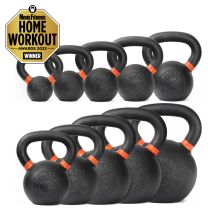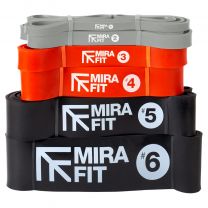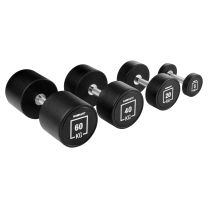Find The Right Type of Strength Training For You
Find The Right Type of Strength Training For You

What is the best strength training option for you? Are you looking to supplement your other activities such as running or are you looking to bulk up? Whatever your training goals, strength training should form a critical part of that training.
Strength training is so much more than just getting stronger. Our bodies are intelligent…it can adapt to the loads that you place on it but it is also equally lazy if you don’t. The body will only recruit the necessary muscle fibres required to get the job done.
To get stronger you need to perform resistance exercises that load your muscles enough to recruit as many muscle fibres as possible. As an endurance athlete you might think that your muscles are contracting sufficiently but the truth is that these are low threshold contractions, otherwise you wouldn't be able to keep performing prolonged training without fatiguing.
Strength training is the best way to activate the higher threshold muscles and get you strong. No matter what your chosen activity is, whether it is swinging a golf club, running a marathon, or playing a contact sport like rugby, strength training should be an integral part of your training. Apart from the increase in strength gains it will improve your muscular coordination, strengthen tendons and ligaments, and help improve mobility.
But what type of strength training is most beneficial to you? Do you even know all the options available to you? We will breakdown the four options for strength training for you, so you know what is best to suit your goals and circumstances.
Body Weight Training

As the name suggests, this form of strength training utilises your own body weight as a resistance to gravity and eliminates the need for weights. Most body weighted exercises have options to progress and regress the exercises so you can find the correct exercise for your strength levels. For instance the push up exercise can be regressed to do push ups on your knees or progress to elevating your feet on an Exercise Step.
This allows you to keep progressing your training as you adapt to the current load. Most exercises involve multi-jointed movements, helping develop the full body. There are a range of exercises that include upper body, lower body, core exercises as well as plyometric exercises such as the squat jump.
Examples of bodyweight training include - walking lunges, single leg deadlifts, Russian twists, pull ups and tricep dips.
Benefits of Bodyweight Training
• Full Body Workout - multi-jointed exercises as well as options for upper body, lower body and core exercise means that no muscle is left untrained.
• Inexpensive - very little equipment is required as you are using your body weight as the resistance.
• Location - you don’t need much space to perform a routine, meaning that you can train from home or the hotel room, so you never have to miss a session or spend time getting to the gym.
• Workout Flow - there is no time wasting between exercises to reset the weights. This means that you not only reduce the amount of time of the session, but you can easily flow from one exercise into the other which helps to keep the heart rate elevated.
Free Weight Training

Think Dumbbells, barbells, Sandbags and kettlebells. All these pieces of equipment would be integral to free weight training where the resistance object is not attached to anything such as the machine weights would be. It requires greater muscle control during the exercise movement compared to machines, but it has the benefit of preventing muscle imbalances.
Free weight training is used across a broad spectrum of training modules such as HIIT, HIRT as well as traditional strength training. It offers a large amount of flexibility where you can perform a range of exercises using a single piece of equipment such as the kettlebell. Free weights have an advantage over body weighted exercises as it is easier to load muscle groups such as when you do squats.
Examples of free weight training include - kettlebell offset lunges, barbell deadlifts, plate crunches, dumbbell renegade rows and dumbbell bench press.
Benefits of Free Weight Training
• Versatile - you can use a single piece of equipment for a range of exercise.
• Accessibility - with a couple of pieces of equipment you are able to get a full workout at home.
• Muscle Imbalance and Stabilisation - avoid muscle imbalances and increase your core strength and stability.
• Mobility - free weights require a greater range of motion and help increase mobility.
• Affordability - there is no need for expensive equipment or gym contracts.
Machine Weight Training

Walking through a gym you will be inundated with the range of gym machines. These machines create resistance through a system of pulleys or rollers that are connected to a rack of weights. The difference between free weights and machines is the fact that the machines control your joint movement during the exercise where free weights do not. This has a benefit for people that are new to training where muscles are still adapting to the movement or when you are returning from injury and want a controlled range of motion.
Examples of machine weight training include - leg press, seated rows, cable palloff press, lateral pull downs and machine bench press.
Benefits of Machine Weight Training
• Recovery from Injury - controlled movement prevents straining of the joint.
• Good for Novices - learn the correct movement before tackling the free weights.
• Ease of Use - changing weights is generally as simple as pushing a pin into the correct weight on the weight rack.
Resistance Band Weight Training

Resistance bands are the ultimate take-with-you piece of equipment as they can fit in any bag. They come in a variety of resistances, from light resistance up to heavy resistance. Whether you are training to increase strength and muscle size or just looking to tone the muscles, you will find a band that has the right resistance for you. The training stimulus of resistance bands is also different to other forms of resistance training as the resistance of the exercise increases during the exercise as opposed to the other forms of strength training where the greatest resistance is at the start of the exercise.
Resistance Bands occur in a number of forms including resistance bands in a loop, floss bands, fabric bands and mini resistance bands. You can increase the variety of exercises by looping resistance bands around an object such as a Resistance Band Peg. Apart from resistance training, resistance bands can also be used to perform flexibility and mobility exercises.
Examples of resistance band training include - banded squat to press, banded deadlift row combo, side plank with one arm rows, horizontal waist rotations and banded push ups.
Benefits of Resistance Band Training
• Inexpensive - resistance bands are the most affordable form of resistance equipment.
• Perfect to travel with - resistance bands can easily fit in your bag.
• Versatility - with a bit of thinking you can train every muscle or movement.
• Flexible - flexibility training can also be done with resistance bands.
No matter what level of sport you are performing at or what activity you are doing, strength should be a vital part of your training. It will help improve stability, reduce risk of injury and improve performance. Use the different options of strength training to suit your needs and remember that these options don’t need to be trained exclusively but can be used in conjunction with each other.
Written by guest author Brendan McBirnie.
For more content, follow us on Instagram @Mirafit Official and on our official Mirafit Facebook page.
Enter your email to signup to our newsletter
Tags: Exercise Type > Strength








